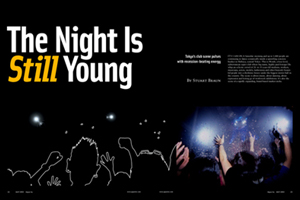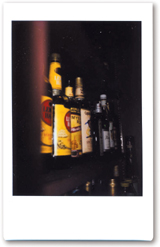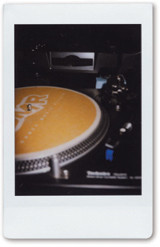The Night is Still Young
Back to Contents of Issue: May 2003
|
|
|
|
by Stuart Braun |
|
 IT'S 5 AM ON a Saturday morning and up to 1,000 people are continuing to dance ecstatically inside a sprawling concrete bunker in Shibuya, central Tokyo. This is Womb, a four-level, subterranean super-club where big name, highly paid foreign DJs whip an eclectic crowd of 20- to 35-year-old students, workers, musicians, actors, models, fashionista and other brazenly beautiful people into a rhythmic frenzy under the biggest mirror ball in the country. The scene is about music, about dancing, about expression and letting go of workweek inhibitions. It's also the scene of a rapidly expanding, brand-based market niche. Womb and the plethora of dance clubs that have risen from the ashes of Japan's crippling economic recession are the sites of a fertile new market, incubators for a potentially huge marketing demographic. People who go to clubs tend to be young, single, have good jobs (it costs up to JPY6,000 just to get into a Tokyo club) and spend a lot more money on clothes, cosmetics, alcohol, cigarettes and electronics than mom or dad would dream of doing. For every new club forming part of the conspicuous nightlife boom that has swept Tokyo in the last decade, there is another sponsor. Another corporation willing to spend big money to have its name associated with the cause celebre of club culture: freedom. Tokyo's nightclub industry has undergone staggering growth since its birth a little more than 10 years ago amid the wreckage of Japan's burst economic bubble. At the time, the city had only two or three dedicated dance clubs and was still a town ruled by karaoke. But today, Tokyo is the Asian hub of the international club scene. Takashi Ishihara, CEO of Cluberria, a Tokyo club culture Web site (www.otaiweb.com/top/hp/clubberia.htm), says the expansion of the club industry has been exponential over the last two or three years. In Shibuya ward alone, up to 20 nightclubs have opened in that brief time span, including a lot of smaller bar/DJ venues that are forming the grassroots of the scene. Meanwhile, the opening of the 3,000-capacity Ageha "super-club" in Shin Kiba last December drove clubland's inevitable spread to the suburbs. One-off club nights at other far-flung venues like Chiba's 10,000-capacity Makuhari Messe, Odaiba's Differ Ariake and Zepp Tokyo predate this trend.
This culture embodies not only a night out dancing, Popular foreign DJs can earn JPY5-10 million for a night in a packed Tokyo club. Even at the smaller clubs, DJs who were getting $1,000 a night 10 years ago are now demanding and getting five or six times that amount. That compares very favorably with major European cities, including London, still considered ground zero of the worldwide clubbing scene. Hard statistics are hazy due to the underground and clandestine nature of an industry long associated with drug use, illegal opening hours and sketchy safety standards (witness the stampede in an after-hours Chicago dance club in mid-February that killed 21 people and the inferno days later at a Rhode Island nightspot that left 99 dead.) Still, it is generally acknowledged that a DJ playing a London super club such as the Ministry of Sound will have a pay scale that peaks at around 10-15,000 pounds (about JPY1.9-2.8 million) for a few hours in the DJ booth. At Womb, the cost to put on the 2003 Countdown Party, featuring big name American and Swedish DJs Richie Hawtin and Sven Vath, was over JPY10 billion, according to Sabi Takahashi, the club's head producer. Cluberria's Ishihara says the market in Japan will continue to grow, while American clubs, which have started to slump in recent years due to restrictions and police crackdowns, are not as likely to sustain the big paychecks.
Club Inc.
This New Year's, AgeHa featured New York house maestro Danny Teraglia, one of the world's most coveted DJs, in what Ishihara claims was a major coup (and undoubtedly a very expensive one). Usen's understanding of the emerging nexus between underground club culture and mainstream music trends was initially taken up by Avex, now Japan's biggest record company, when in the mid-1990s it bought one of Tokyo's most influential dance clubs, Velfarre. Opened in December 1994 as a de facto replacement for Juliana's, the most famous club in Tokyo at the time, Velfarre soon became the testing ground for Avex's increasing efforts to fuse dance music with the more orthodox, but tiring, J pop sound. As a result, J pop super starlets including Namie Amuro and Ayumi Hamasaki started appearing at the club, where they featured their now famous "trance" remixes. The strategy has worked, and Avex is bringing in a big part of its multibillion-yen revenues from dance music spawned at the Velfarre nightclub. Though entertainment industries tend to do well during hard economic times, the invigoration of the nightclub scene in Tokyo has not happened by default. With fashion and music, clubbing defines a new urban, underground consciousness that has been evolving globally with disco, hip-hop and house music since the late 1970s. But in Tokyo, a delicate confluence of cultural, economic, technological and even political factors have made the city fertile soil for a peculiarly corporate club industry that is pressing into the mainstream. While it is technically illegal in Tokyo for people to dance after 1 am, city police turn a blind eye to these activities, and some Tokyo clubs stay open till 10 in the morning. In New York and many European cities, most clubs are forced to adhere to a strict 4 am closing time. The loose application of the law in Tokyo, along with irregular zoning regulations, has allowed nightclubs to spring up in every unoccupied furrow of the city, notes Laymont Raymond, a club promoter in Tokyo for over 10 years. Raymond recalls the days before the boom, when there were no longer any legal clubs in Tokyo. "The big clubs, Yello and Gold, had both been closed down by the police because dancing past 12:00am [the extra hour was added only last year] was illegal, and there was a big police crackdown," he says. His promotion company, In Action, "started having all night events in event spaces, which is legal. By organizing private parties, we were able to find a loophole in the law." Ishihara says the increasingly lax application of the law is related to Japan's unique "compromise" culture of tatemae (principle) and honne (reality), a point confirmed by Raymond. "Most clubs have good relationships with the police -- they pay off the police or operate as event spaces so they do not fall under the category of a club," he says, adding that "most event spaces and clubs are now built in areas where people don't live to avoid noise problems."
Cool hunters
After running a monthly party at Twilo, Takahashi was approached by the management of Womb, which was struggling to find a visionary concept of its own. "They were attracting about 150 people a night at that point," Takahashi recalls. "Now over 1,000 people are coming to the club on Fridays and Saturdays." The reason for the shift, says co-producer Takeo Yatabe, is that "we made a culture out of the club scene." This culture embodies not only a night out dancing, but a complete urban lifestyle, including everything from what people drink, wear, listen to, think and shampoo their hair with in the morning. The concept was arguably first given life by the London club Ministry of Sound, which today refers to its club concept as a "dance brand". Its interests range from nightclubs -- including its recently opened venue in Bangkok -- to record production, magazines and festivals. In 2001, 3i, Europe's leading venture capitalist, invested 24 million pounds in this "dance brand."
Young people are working less, In Japan, Takahashi has been able to sell this brand concept to Calvin Klein, Nike, Sony, liquor and cigarette companies, and others. These interests form a conspicuous presence in the club scene by sponsoring special promotions, getting their logos on all club publicity, or providing exclusive brands of beer and vodka. As a result, Takahashi has been able to spend more money on big name DJs, better lighting, promotion, dŽcor and so on. This has been important in ensuring that Japan's fastidious, demanding and impatient youth generation are willing to buy into the culture and concepts. Under the name Form, Takahashi and Yatabe have leveraged off Womb to expand into a "cool consultancy." In the parlance of Naomi Klein, author of the bible on corporate branding, No Logo, they are "cool hunters" who are giving corporate Japan direct access to a murky underground inhabited by a highly sought-after market demographic that could deliver explosive growth. Cluberria's Ishihara predicts that the Tokyo club industry will double its growth in the very near future.
Liquor and cigarette companies initially started to push their products to Japan's club generation about five years ago, when new legislation banned them from advertising to people under 20. Since you have to be over 20 to legally enter a club in Japan, clubs become the perfect forum for legitimate advertising to young people. (Advertisers know, of course, that many people under 20 are habitual clubbers who can easily get into the venues). Ishihara calls it a "closed world," a guaranteed market of self-selected consumers. Indeed, the rapid rise of tobacco sponsorship in clubs and bars since the 1990s globally has been well documented. Corporate sponsorship started conspicuously in Japan in 1996, notes Ishihara, when Grammy award-winning producer and DJ Little Louis Vega received an unprecedented JPY3 million from Gordon's Gin to spin his magic in a Tokyo club. Though corporate sponsorship has long been a part of Europe's more established club scene, many European clubs are now actually moving in on Tokyo to grab a slice of the city's lucrative dance market. Recently, veteran London super-club Slinky took over an existing six-level venue called Cube in Tokyo's Tamachi district for three months, touting an international DJ lineup and the prerequisite high-profile sponsorship from a major cigarette brand. Free yourself
That has changed. Now nightclubs provide a vibrant forum in which Japanese people can expand their global horizons and express, or at least discover, their unique personalities. What was once a niche-oriented, underground club scene financed by small-scale independent investors is today a rapidly growing corporate domain, a lucrative empire being built on a synthesis of music, fashion, international product branding and multinational record sales. In Tokyo, the party's only just begun. @
|
|
Note: The function "email this page" is currently not supported for this page.








